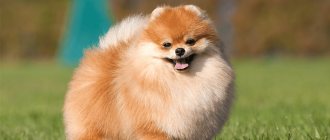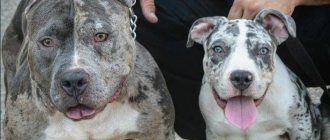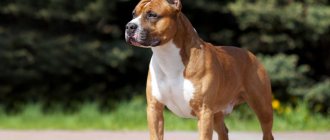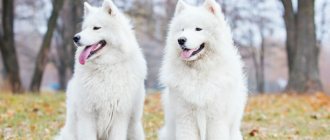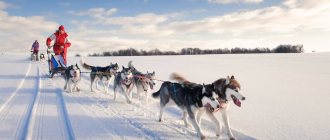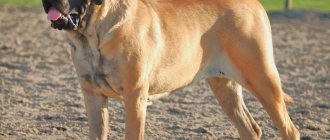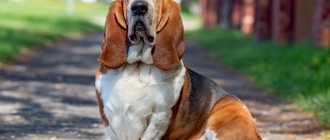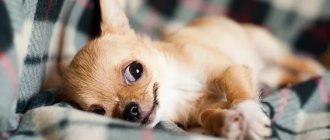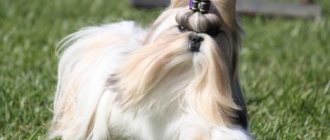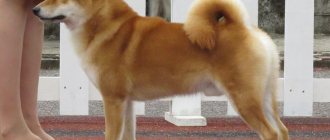Do you think that all dogs understand humans and learn quickly? Alas, no - there are breeds that have difficulty remembering commands and often do strange things. Conventionally, they can be called stupid, but often the point is not in mental abilities, but in a fair amount of stubbornness or psycho-emotional characteristics (for example, increased excitability or fearfulness, when in a fit of “passion” the animal becomes uncontrollable).
- 2 Afghan Hound
- 3 Chow chow
- 4 Husky
- 5 Beagle
- 6 English Bulldog
- 7 Mastiffs
- 8 Toy Terrier
- 9 Photo gallery: other dog breeds considered not very smart
- 10 Video: stupid dogs
Basset Hound
Calm and sociable dogs, friendly to other animals and children.
Like many other “stupid dogs,” Bassets can be stubborn, slow, and pay more attention to the amazing smells around them rather than to their owner’s commands. For a treat, they will do what you want them to do. However, if you have nothing to offer your basset, he will “forget” the learned command. Don't be fooled by the Basset Hound's sad eyes; behind them lies a strong, inquisitive and unwilling personality.
Photo gallery: other dog breeds considered not very smart
The German Spitz is a small but very desperate dog that loses its mind during showdowns with “enemies”
The Jack Russell Terrier loves noisy games, but when he gets excited, he stops listening to his owner and seems incredibly stupid
The Bloodhound is not stupid, but it is difficult to train due to its incredible laziness
The Basenji is a stubborn dog that cannot be forced to do what it does not like. Training Basset Hounds is a difficult task, since dogs remember commands for a long time and do not really like to carry them out. Shih Tzus are very headstrong dogs, and when their wishes are not fulfilled, they begin to “ swear"
Basenji (African non-barking dog)
Basenji Basenji is a rare breed in European countries.
It was bred in Africa for the purpose of hunting and pursuing prey. The pet copes with its direct responsibilities perfectly, but does not shine with a sharp mind. Basenjis are not prone to training; they have a hard time accepting and remembering new information. By nature they are stubborn and self-willed, they are in no hurry to carry out commands, expecting motivation in the form of treats. To properly raise such a dog, daily training is necessary - in the absence of training, it will quickly forget everything that the owner taught. Outside of hunting, such pets are lazy and do not bother themselves with brain activity, preferring to passively and mindlessly observe what is happening around them. Ideal for living in an apartment - Basenjis do not bark and are extremely clean.
Where to start training a husky
Husky training is special: these dogs themselves are fundamentally different from all breeds common in European countries.
People tried to instill in the local animals qualities that would help in solving the problems of owning property: its protection, protection from attacking enemies.
Trainers could also pursue opposite goals - the dog was taught to be an offensive weapon.
The Siberian Husky is not designed for any of these activities: it has lived for hundreds of years in a world where property is everything around it.
According to the dog, it cannot be mastered alone: one can conquer the vast expanse in a pack, completely subordinate to a powerful creature who knows what, why and when to do in order to achieve the goal.
Huskies have little interest in security; the dog has difficulty understanding who to bark at and why.
A sled dog, the leader is accustomed to commanding his own kind and obeying a person.
Knowing the characteristics of the breed makes it possible to answer questions about why and how to train a husky before purchasing a dog.
Mastiff
You wouldn't dare say "stupid dog" directly to a big, muscular mastiff's face.
However, (behind their backs) we admit that a high level of activity and ease of training are not among the hallmarks of this breed. Due to the breed's enormous size and good guarding qualities, it is important that the mastiff owner begins training and socialization of his pet at an early puppy stage. And then the mastiff will become a respectable and formidable protector of the whole family.
Character and temperament
Initially, huskies were sled dogs and this determined their character traits. They are characterized by intelligence and independence - the leader himself chose the most convenient path, focusing on a given direction, everyone else worked in the same mode. Lazy dogs were punished by the pack itself, and this developed the breed's habit of working with full dedication, while appreciating the “contributions” of others. Hence the tendency of these dogs to imitate.
At the same time, they are weakly attached to the owner, since usually the team was used by different people.
The hunting instinct is highly developed and without socialization these dogs perceive other domestic animals as prey. Security instincts are very poorly developed.
There is a strong tendency to dominate: without proper training, huskies impose their own rules on their family, and even bite when they “disobey.” This breed is categorically not recommended for beginners, since it is very difficult for a beginner to train restive huskies correctly.
On the street, it is better to let them off the leash less often - huskies tend to run away and wander.
Beagle
These dogs love to follow where their scent leads, which can sometimes lead to trouble. The Beagle's cheerful and affectionate nature, combined with its deceptively sad look, may make you think that it is the perfect pet toy. But that's not true. Beagles are extremely active and purposeful dogs, they have a difficult character and cannot resist the desire to explore the world. Because of their unique sense of smell, this breed helps police officers search for explosives.
Questions and answers
What is a mini husky called?
A mini copy of the sled dog is called “Klee Kai”. This name comes from the language of one indigenous tribe of Alaska - the Inuit. Translated, the word means “little dog.”
What size are mini huskies?
Pocket-sized Alaskans are divided into three groups based on height and weight. The largest Klee Kai (standard version) grows up to 43 cm and can weigh up to 10 kg. The next variety (mini) reaches 39 cm and 6.8 kg, and the tiniest (toy) is no higher than 34 cm and no heavier than 4.1 kg.
Shih Tzu
At first glance, dogs of this breed resemble plush toys, which is not so far from reality. These are small animals with luxurious fur, long flowing strands, different colors (most often light or reddish) and a cute face. The breed is classified as decorative and is extremely difficult to train, which is due to the long history of its origin.
Shih Tzus were bred for beauty, not intelligence.
Shih Tzus were bred specifically for representatives of royal families back in the Ming Dynasty, and their main function was to recline with a languid look on pillows, calmly enduring the affection and hugs of their owner. They did not require the ability to follow commands and obey, so modern descendants of the royal Shih Tzu are not distinguished by high intelligence. But they are great as a sweet and kind pet, they are practically non-aggressive, and are great for those who want to have a living, beautiful toy and agree to look after it.
How to choose a mini-husky puppy?
For breeding and exhibitions, an impeccable pedigree and documents are required. Only a nursery with a good reputation can provide such puppies. It is better to choose a puppy from a small litter. It is advisable to see how babies interact with each other in familiar conditions, during play or feeding. If the puppy approaches the potential owner on his own, this is an opportunity that cannot be missed.
Buying puppies secondhand is risky, even if you don’t want a show specimen, but a funny companion. There is no guarantee that it is the Click Kai that is being sold; there may be problems with heredity or vaccinations. It is difficult even for a specialist to determine the purity of a breed by eye.
Pekingese
Unlike many breeds that were originally conceived as working dogs and later became companions, the Pekingese from the very beginning played only one role - as a human pet. Intelligence has always ranked last on the list of qualities of this breed. But Pekingese are very beautiful, cheerful, friendly and can be kept in a small apartment.
Who are Huskies: a brief description of the breed
Husky is an ancient breed that was bred specifically to ride in sleds with luggage and a person. Over time, breeders began to focus not on the working qualities of the dog, but on its beauty. Particular attention is paid to the exterior, the characteristics of which are as follows:
- Weight. The weight category for females is from 15 to 23 kg, and for males 20-28 kg.
- Height. At the withers, the height of the female reaches 50-56 cm, and that of the male 53-60 cm.
- Color. There are several varieties of color, but the most common are black and white, gray and white and chocolate white.
- The eyes are almond-shaped, slightly slanted towards the nose, but the gaze is direct. Their color ranges from dark brown to light blue, but heterochromia occurs - different eye colors.
- The life expectancy of representatives of this breed is on average up to 15 years.
Important! The uniqueness of this breed is their muzzle, which has a black or white mask.
The breed was bred to help humans, but has now become more of a friend
Yorkshire Terrier
One of the smallest dog breeds in the world is also one of the most playful.
Yorkies are very naughty and active, and their small size allows them to get into places in your home where they clearly shouldn't be. They can even sneak under a person sitting on the sofa. Many Yorkie dogs love to mark things in the house, even if they do their “business” outside. These dogs are also very playful, constantly getting underfoot and trying to protect the owner from any threat, even if it is several times larger than a Yorkie.
Dog in an apartment, house, enclosure
The character traits characteristic of huskies most often manifest themselves as follows at home:
- does not “hear” commands well - she trusts her feelings more than her owner;
- studies the world, tries out all available objects “by tooth”;
- capable of educating and training those around her, she can train them as she sees fit - the dog bites household members, growls, demonstrates superiority;
- She independently decides how to survive, often regardless of the opinions of other creatures living nearby: she can change the pack or find another - a more generous breadwinner.
The owner is left with two options: place the dog in an enclosure installed on a concrete floor, or become the leader of a pack in which the dog will feel useful.
Bloodhound
The Bloodhound “sees” the world primarily with its extremely sensitive nose. These dogs are difficult to train because they are constantly distracted by all the smells around them. They also have a ton of energy, stubbornness and determination, and are absolutely unstoppable once they get on the scent trail. It is unlikely that you will be able to force a Bloodhound to do anything against its will. But on a large plot outside the city, where the dog can move freely, your pet will be happy, cheerful and satisfied with life.
Rewards and punishments
Let's look at how to properly train a Husky at home.
Training must include rewards for correct execution of commands. At first these should be mostly treats, then they are increasingly replaced with praise.
You cannot beat huskies: dogs “trained” in this way will take revenge on occasion. What to do if unacceptable behavior occurs? Press the puppy to the floor and release it when it stops struggling. Another option: lift it by the scruff of the neck and hold it a little. It is necessary to punish for misconduct immediately, then the puppy will not associate incorrect behavior with punishment.
Russian greyhound
These dogs with amazingly beautiful silky hair are independent freethinkers.
They can also be extremely stubborn, so training a greyhound is an exercise in patience. Frequent but short training sessions are best for these dogs rather than hour-long sessions. At home, they are usually very well-mannered, calm, clean and very affectionate.
Character, upbringing, training courses
Dogs, like people, do not have the same character, but each husky has at the genetic level:
- attachment to a person - girls are more tender and affectionate, boys are less emotional, but very devoted to their family;
- love for children - huskies will allow little ones to do everything and will not show their dissatisfaction with anything;
- endurance - not afraid of severe frosts (up to 60 degrees below zero), capable of running up to 150 km per day. The peculiarity of the body is that they are able to slow down or speed up metabolism, quickly recover after serious exercise;
- love of freedom, which often causes dogs to run away from home. They can easily jump over a two-meter fence, dig under a hole, open a lock on a door, or simply run away while walking. When walking, it is advisable not to let even a well-mannered husky off the leash;
- independence, which makes the dog difficult to train.
Another feature is that huskies do not bark. Out of impatience, indignation, joy, they howl, sing, and make sounds similar to human speech - this is their way of communication.
According to the Stanley Corren scale, huskies are a breed of average ability. They learn commands after 15-20 repetitions, and in the absence of daily training they lose their skills. But many husky owners are convinced that their pet understands perfectly well what they want from him the first time, and simply evaluates whether it needs to be done.
The animal is too thinking and independent, it can think outside the box, which complicates training. Only after long training will you be able to ensure that your Husky behaves like a well-mannered dog.
In general, the acquisition of skills depends on proper upbringing from childhood and on how much time you are willing to spend on training your pet.
The breed is not endowed with protective qualities. Dog handlers do not recommend raising them as watchdogs. Trained huskies do not show the necessary zeal, since aggressiveness is not their case. Attempts to unblock aggression often lead to mental disorders - the dog will become uncontrollable. The hunter's instinct acts more as a way to feed itself, which is very important in natural habitats in the northern regions. But you are unlikely to succeed in raising a husky as a hunting dog.
Their true nature is harness riding, in which they show their best qualities - intelligence and determination. This is a pet for active owners who love nature and intend to engage in sports - skijoring, bikejoring and other types. Joint activities will help you strengthen mutual understanding and relationships with your student.
Siberian Husky
A beautiful dog, similar to a wolf, but gentle and friendly with almost all people.
Husky loves the outdoors and needs to travel every day. He is smart, but free-spirited and independent, which makes training a Husky a challenge. Very often, huskies run away from home, and with incomprehensible cunning they even manage to free themselves from their leash. And they can easily jump even over a high fence.
Leaving a husky alone without communication, physical and mental stress is a sure way to return to a house destroyed from walls to floors.
Pocket size wolf
Small, charming and friendly dogs, similar to Siberian Huskies, are always the center of attention. They are sociable, talkative, curious, and enjoy participating in children's games. The disadvantages of the breed include the high price, difficulty in training and selecting a partner for mating. For those who are not afraid of this and who have time for a pet, the Klee Kai will become a good friend and a reliable “live alarm.”
Alaskan Mini Huskies are curious, active and cheerful creatures with high sociability. They require little care and are excellent companions and guards. Small defenders will not attack the enemy, but they will loudly inform the owner about any problem. They absolutely cannot stand loneliness and are capable of greatly “tweaking” the interior if left in an empty apartment. They require attention, long walks and respect. You can feed your babies both natural and ready-made food, but these two types of feeding cannot be mixed.
Chow chow
Chow chows may look like adorable teddy bears, but they are not always sweet and kind.
Created to be guard dogs, Chow Chows are serious, independent and fearless animals. They are strong-willed and stubborn, and also very strong, so an experienced dog breeder is needed for training. The Chow Chow is not the stupidest dog in the world, she just has her own mind. A well-bred Chow Chow dog is a noble, loyal and reliable companion.
Training and teaching commands
Husky training at home should be regular, but not boring. It is better to do it in the form of a game. When you train your dog, your voice should be calm, even and low - this breed does not tolerate shrill intonations. Often such dogs are more effective in the form of a request than an order.
Training a husky puppy begins with the command “Come to me!” Moving a couple of meters away from the dog, say the command in a friendly manner and show the treat. Praise as soon as the puppy moves in your direction. Give a treat for completing the command correctly. Also use these words when calling your dog for regular feeding.
An important part of training a husky is the “Place!” command. The baby needs to be taught it from the first days. Each time you take him to his bed to rest, repeat “Place!” To teach your puppy to return to the bed on command, you can put a treat there. If the baby categorically ignores the bedding, check it - it may be uncomfortable, located in a draft, etc.
It is very important to teach your husky the “Fu!” command. Stop the unwanted action: take the forbidden thing from the puppy, push it away from the dangerous place, sharply and firmly saying “Ugh!” If the animal repeats the prohibited action, pin it to the floor.
To teach your dog to sit on command, show him a piece of treat, raising your hand so that he can only see it while sitting. You can follow the spoken command by pressing the croup.
Team "Near!" taught using a leash, holding the dog close to you and rewarding with treats or praise for obedience. Attempts to fall behind or run ahead are stopped by a jerk of the leash.
Team "Voice!" You can say it when the puppy barks on its own initiative, or you can tease it with a treat, holding it above your head. Sometimes, however, at this command the huskies do not so much bark as howl, but this is also the result.
Bulldog
This breed is known for its stubbornness.
English bulldogs are calm, and even lazy, but at the same time they are ruggedly elegant and very affectionate towards people. They are excellent companion dogs for the phlegmatic person. And French bulldogs are more temperamental than their English counterparts, friendly, do not require long walks and are ideal for busy people. Because of their lazy nature, stubbornness, and tendency to get distracted, bulldogs require longer training than other dog breeds. They are not the best guards for a private home, they are not service dogs, and they do not strive to obey commands in an exemplary manner, like, for example, a German shepherd. The Bulldog is an excellent family companion dog and don't expect much more from it.
Breed Features
Great freedom implies responsibility: on the road, the leader independently determined the path, without asking the owner and without giving in to obstacles.
The rest pulled the lines together, not daring to stop or slow down: the flock independently punished the sloth.
Genetic memory of the conditions of their previous life dictates their line of behavior - to work with complete dedication, to evaluate the efforts of others, to find their own shortest path to the goal.
Hunting instincts are developed in the same way as those of its ancestor, the wolf. The dog sees all foreign creatures, except humans, as potential victims.
A dog raised in an apartment is dangerous to surrounding cats and other domestic animals. If from the first days the dog lived with a cat, and on the street it will be indifferent to their appearance.
The dog’s attitude towards people is different - it often changed owners, like sleds, so it was not used to giving preference to someone alone.
The dog does not distinguish between strangers: it can perceive a stranger as a potential threat to itself, but not to its owner’s property.
Attempts to instill in a domesticated wolf aggressive skills towards people can lead to the fact that the embittered dog will strive to destroy everyone who is weaker than him at the moment.
Border Collie
The smart dog was specially bred with the indicated parameters. Among domestic dog breeds, border collies are the smartest! Confirmed by breed breeders, outside observers, dog handlers, and breeding establishments. Dogs have a number of advantages:
- medium size, allowing you to get a dog outside the city, in urban conditions;
- noticeable activity makes the owner mobile - important in modern society;
- the highest ability to learn will facilitate the process of training and education;
- life expectancy – 16 years;
- suitable as a gift for a teenager over 12 years old;
- gets along with the owner's family, children, animals, strangers;
- companion, pet, sheep shepherd in villages, villages.
Let us note complex nuances for the owner. You will have to constantly take care of your pet's fur. The coat is the pride of the border collie! You need to bathe your pet up to 4 times a year. If you are not ready to show mobility, play, run with the dog, walk at least a couple of hours a day - do not take a closer look at the described breed. Suitable for active people who love guests, sports, family walks, and outings.
Command training
Before you start teaching the puppy to follow commands, he is taught his own nickname. The name for the husky is chosen to be short, sonorous, consisting of 2-3 simple syllables. The puppy quickly gets used to the name if you call him his name every time you pick him up, pet him, or put him in a bowl of food. Associations with a dog’s nickname should only be positive.
This command is not difficult to teach. A puppy that loves its owner is always happy to run towards him. It is enough to catch the moment of the beginning of the movement towards you and voice “to me”. The dog that runs up is petted and praised. A timid or not fully accustomed puppy can be lured with a treat or toy. A little later, the voice command can be accompanied by a clap of the hand on the thigh or a snap of the fingers. The dog will remember the gesture and sound and will respond to this signal.
Basenji
This African non-barking dog is known for its independence and aloofness.
Some people describe the breed as having cat-like qualities, and in fact many Basenjis paw-wash themselves like cats. Basenji dogs have earned a reputation for being "unmanageable," but in this case, ease of training is not always an accurate indicator of intelligence. On the contrary, these animals are smart, curious and playful. They have excellent hunting qualities and are still used for hunting in the Congo.
Training a Basenji can sometimes feel like taming a wild animal. They are vigilant and careful, and also fearless and very stubborn. You cannot educate them with a stick, only with patience and affection.
Let's start teaching commands
The first exercises will not require much effort. The dog will respond to the nickname if, for starters, you call it before eating.
Next you need to learn to follow the command “come to me!” She is accompanied by calling the dog by name, stimulated with a friendly voice, a toy, and occasionally a treat.
Raising a dog that is more preoccupied with itself than with following commands requires the help of playful, role-playing training: a disobedient puppy can be encouraged to search for its owner by hiding from him or moving away to a long distance. The call must continue.
Under no circumstances should you run after your baby around the apartment - the dog must strive to find its owner in order to receive a prize.
The toilet habit is also developed. The cuvette is placed in one place, and the puppy is lured there 15–20 minutes after eating.
The learning process is accompanied by praise. As the actions are successfully repeated, the skills at the end of the procedure can be reinforced with a game or a treat. This should be done immediately after the dog completes all actions.
It doesn’t matter what breed your pet is, it must be well-mannered and understand basic commands so that it doesn’t scare passers-by while walking without a leash. Check out this video and you will learn how to teach your pet simple commands.
Afghan Hound
It can be said that these graceful dogs with luxurious long hair are ruled by the nose.
For this reason, Afghans are difficult to train because they don't look up, they look down. Dogs of this breed are not very interested in listening to or pleasing people. They are more interested in what smells around them and also want to chase anything that moves. At the same time, Afghans are very affectionate and kind animals. And the fact that they are in no hurry to obey the owner’s commands does not mean that the pet is unteachable. The Afghan Hound was bred for hunting. Often these dogs overtook a hunter on horseback and chased the animal on their own, without instructions from a person. Thanks to this, they developed an independent and persistent character. Give your Afghan the opportunity to show his hunting temperament and you will not find a better companion.
Not all scientists agree with the classification of the stupidest dogs from Koren's list.
“I don't think there are such things as smart dogs and stupid dogs. This is simply a return to the linear version of intelligence, as if intelligence is a cup of coffee that is more or less full. Different dogs are good at different things. And they are all geniuses in their own way,” says Brian Hare, an associate professor of evolutionary anthropology at Duke University in North Carolina.
The origin story of the little husky
Huskies are not a separate breed, but a whole group that includes both huge Malamutes and tiny Klee Kais. Representatives of this family have long and deservedly enjoyed the love of their owners, but keeping a sled dog in an apartment is troublesome. He needs space and freedom. An alternative to large representatives of the breed is the “apartment” Klee Kai.
The official name of the tiny husky is Alaskan Klee Kai. The breed was bred by the Sparling family in Alaska from 1970 to 1988. Until 1988, the rights to the breed belonged only to this family, then private breeders gave official permission to everyone to breed miniature dogs. This is the result of crossing Siberian and Alaskan huskies, to which the blood of American Eskimo dogs and the Belgian Schipperke herding breed was subsequently added.
And it all started, as usual, thanks to chance. Linda Sparling saw an unusual small dog from her relatives, whose color and appearance resembled a smaller copy of a husky. The woman literally fell in love with this miracle, persuaded her family to give Khasenysh to her and began breeding a “severe Arctic beast” in a pocket format. It took almost twenty years of work to achieve this goal.
The name of a variety of Alaskan husky that does not grow comes from the language of one of the peoples of the northern part of America. The Inuit dubbed the baby “klee-kai,” which simply means “little dog.” The first puppy of the new species was presented “in public” only in 1987. And a miracle happened - everyone wanted to have a funny “northern wolf cub” who would never grow big. Newspapers, radio and television trumpeted about him, his photos flashed on the pages of magazines, the breeders' house became a magnet for dog breeders.
Golden retriever
The large breed will not leave anyone indifferent. The attractive dog has luxurious fur that seems to shimmer in the sunlight. The difficulty in keeping a pet is caring for the pet's hair. It's hard at first, but then you get used to it. The Golden Retriever is a hunter by nature. They love water, swim, and are happy to keep company in the river or pool. Obedience courses are better - basic, advanced standard.
- The breed is friendly and good-natured.
- Dogs are confident and easily make the necessary decisions.
- They love children and are patient with their antics and behavior.
- Suitable for children over 11 years old for independent education.
- They easily find a common language with strangers and play with them.
- Training seems to be the simplest, because the pet tries to please the owner.
- They live on average up to 13 years.
- They need bathing 2 times a year. A haircut is needed regularly.
- Monitor the condition of your ears - there is a tendency to become infected.
- Intelligence is in the blood - don’t take them as guards, they don’t even bark much.
- Suitable for hunting, for official purposes (search and rescue), for helping the blind (guides).
The main thing in education is good manners
Training and education of a husky puppy begins from the first minute of his appearance in the apartment - the owner must show with all his appearance that he has made a firm decision and determined once and for all:
- the place where the dog will live - in the bedroom, hallway, in a chair or in a designated place, maybe in an enclosure;
- objects with which the puppy will play - shoes, pillows or his own toys;
- Kokov will develop the dog’s ability to go to the toilet anywhere or in the right place;
- how the dog will eat - from the hand, when it wants something tasty, or on time - to eat according to the established diet (from five times a day to once, depending on the age of the dog).
How to train a husky to behave outdoors
The Husky is a lively, hyperactive dog, and it needs to be carefully taught how to behave outdoors.
From about two months of age, the puppy can be accustomed to a collar and leash. At first, this can be done at home, because until the baby has received all the vaccinations, you should not take him outside. Make sure that the collar is not tightened too tightly so that it puts pressure on the neck, but not too loosely so that the puppy does not take it off. It will take a little time and the husky will get used to the collar.
Important! Walking down the street with an untrained husky without a leash is not recommended. Dogs of this breed are too playful and prone to running away. And it is almost impossible to catch up with them. Therefore, such a dog can only be let off a leash in a specialized fenced area.
Initially, you should walk the dog in quiet, uncrowded places so that it gradually gets used to the noise of the city, other people and animals. Here you need to strictly monitor your pet, prohibiting him from picking up sticks and bones from the ground or pestering people and other animals.
